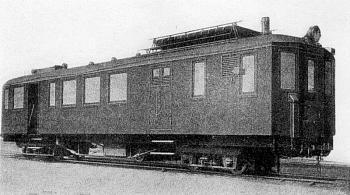| 44 | B A L D W I N L O C O M O T I V E S |
|
|
|
unit; one which can be kept well within
the restrictions of axle loadings, while
allowing a high weight per horse-power
developed. Many experiments were carried out in Europe and America with self-propelled |
The same builders delivered to the same railway in 1924 a later type of car having an engine of 250 horse-power, using solid injection, and of the appearance of an ordinary passenger coach. It is 65 ft. long, weighs 58 tons, and provides |
|
very economical results. A disinterested
report of 1922 states the fuel consumption
as averaging .369 kilograms of oil per train
kilometer (1.3 lb. per train mile). The most modern type of self-propelled vehicles used today in Europe are the Sulzer-Diesel cars of the Swiss-Federal Railways. The Swiss Railways are abandoning steam locomotives and electrifying all main lines, operating the branch lines by self-contained units driven directly or indirectly by internal combustion motors. Sulzer Brothers of Winterthur produced in 1922 for the Swiss Federal Railways a type of vehicle equipped with a 200 horse-power two-cycle Diesel engine coupled to a 140 k.w. generator. The power plant was placed on the leading truck. The drive was by means of two motors connected to the rear truck through a jack shaft and connecting rods. During one month's test, the average fuel consumption was 12.3 grams per ton-kilometer (about 0.7 ounces per ton-mile). Speeds up to 75 kilometers (47 miles) per hour were attained. |
and the
railway considers the machine highly satisfactory. The Canadian National Railways have lately put into operation two types of Diesel-electric passenger cars which were built in their Montreal shops. The "single" car is 60 ft. long, carried on two four-wheeled trucks and has seating capacity for 57 passengers. It weighs 55 tons and for power plant has a "Beardmore" Diesel engine of 185 horse-power coupled to a generator of 105 k. w. capacity, separately excited. Storage batteries are furnished for lighting, charging the exciter and starting the engine. The "articulated" car is carried on three four-wheeled trucks, one of which is located between the two body sections. It is 102 ft. long, weighs 94 tons and has seating capacity for 126 passengers. Its power plant consists of a "Beardmore" Diesel engine of 340 horse-power coupled to a generator of 200 k. w. capacity. "Exide" storage batteries function in the same manner as those on the "single" car. Both vehicles are of double-end control. The electrical equipment of the "single" |
 Canadian National "Diesel-electric Car" |
